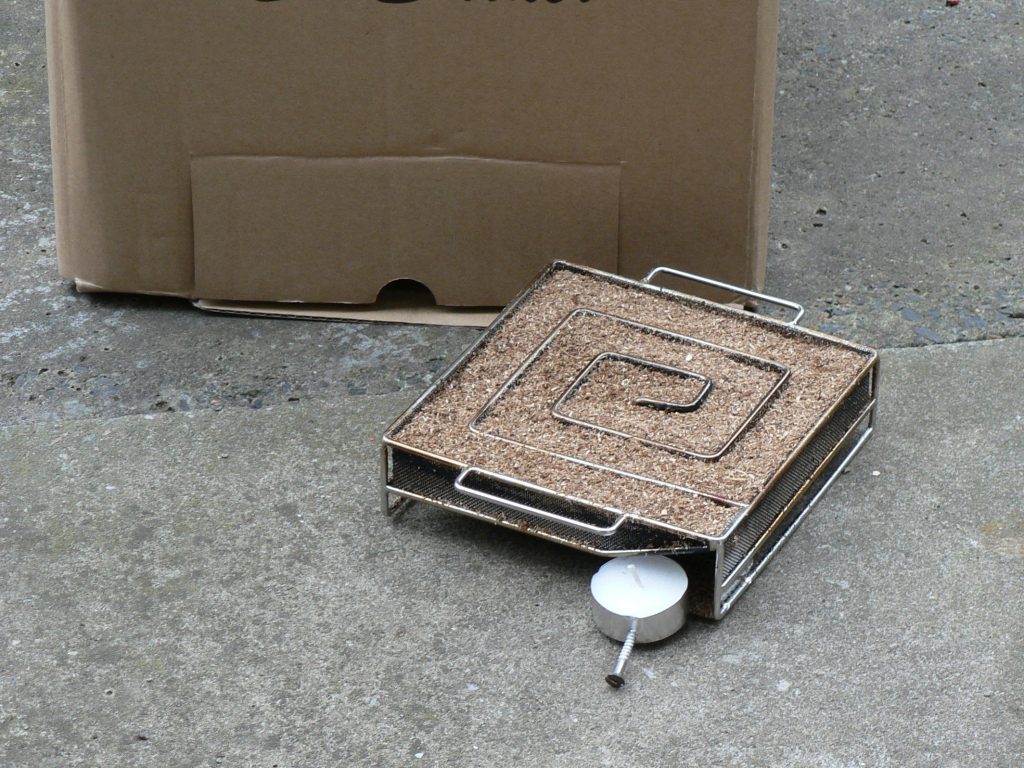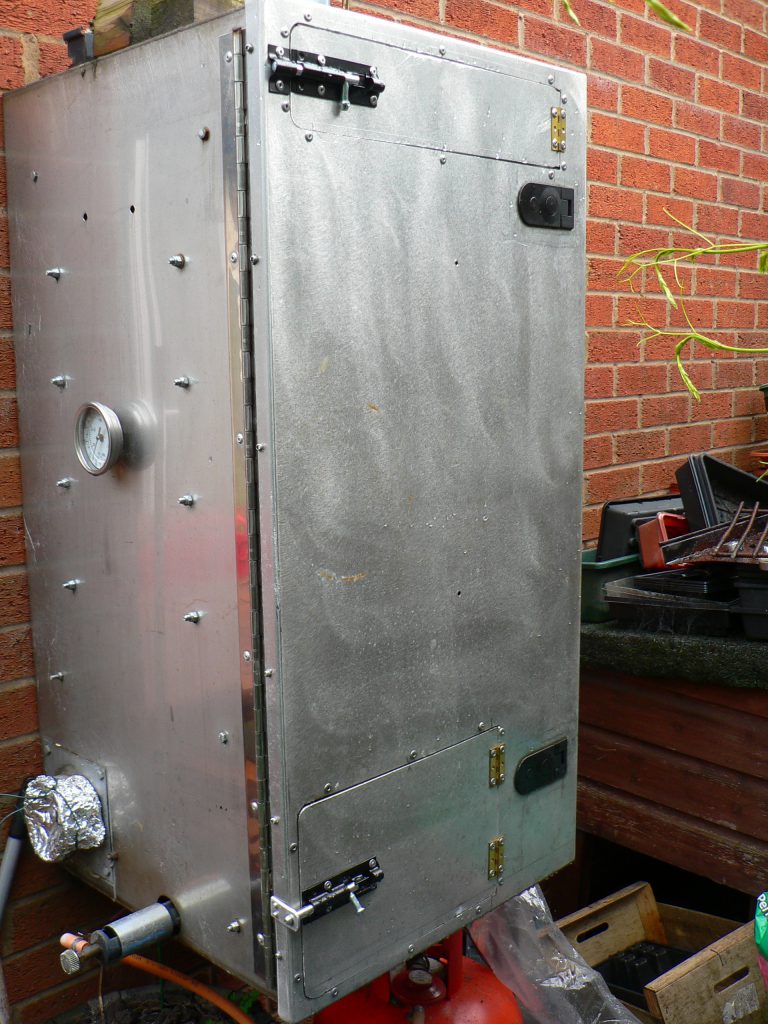In 2012, when I wrote this, people were only just starting to realise that smoking meat didn’t need to be the preserve of the expert and that there was an alternative to barbecues that consisted of burnt sausages and dried up burgers.
This post is completely out of date. I leave it here for the sake of posterity:
In a previous post, I said I’d give further details of the options for smoking, grilling and barbecuing food. My health and other factors have delayed this, but here goes…
…Let’s start cold and get hotter!
Cold Smoking
So to cold smoking.
What’s that?
It’s a method of smoking food at temperatures below 30°C/86°F (approx) so that it is still uncooked. It’s the method that produces smoked salmon that when thinly sliced and nicely presented sells for silly money. The cold process also allows items that would otherwise melt, such as cheese and butter, to be smoked.
Surely, I can’t do that?
Well here’s news for you: you can. In fact, it’s easy; all you need is one of these cold smoke generators. With this, you can smoke fish, meat, cheese, eggs, even salt, the list’s as big as your imagination. Just find a suitable container: a cardboard box, old fridge, barrel, large bucket etc and you’re away. You can even buy a ready-made cardboard smoker – it may seem expensive and hardly durable but the one I road-tested in 2010 is still being used regularly by a friend of mine.

There are many other methods of cold smoking; I’ve tried many of them. None are as cheap, easy, and produce smoke for as long without intervention as this.
As to the cold smoking process, this normally involves brining, dry salting or curing the meat/fish and then smoking it for anything from 12 hours up to 7 – 10 days for large hams. With items such as fish that are salted rather than cured, it is necessary to achieve a certain weight loss to make the product safer. Further details of the smoking process (for salmon) can be found in my A Tale of Cold Smoked Salmon post or in this advice from the Torry Research Station
(Note: The Cold smoke generator and accessories may be cheaper from a ProQ stockist rather than direct.)
Hot Smoking
There are three main types of hot smoking and with all of them you end up with a fully cooked, ready-to-eat, product. They differ only in the temperature and the length of time for which the food is smoked.
Traditional Hot Smoking
To call it hot smoking is really a bit of a red-herring, it’s not exactly hot. It works at temperatures in a band between 41°C/105°F and 80°C/176°F (although smoke will usually be applied only up to about 60°C/140°F). That’s right at the bottom end of domestic oven temperatures. The reason for using such low temperatures is to allow items such as sausage and luncheon meats to be smoked without the fat in them melting. Think fat around the meat in a tin of corned beef and you’ll see why we want to avoid this.
Cabinet smokers using gas or electricity as a heat source are the easiest to control at these temperatures over the comparatively long time that hot smoking takes.
Regrettably, the UK is way behind the USA in manufacturing smokers specifically for this purpose. The main one seen regularly is the Bradley Smoker, a great machine if you don’t mind the cost of the special wood pellets that it uses. Cabinet smokers are also available from Outdoor Cook and The Garden Gift Shop. I have not seen or used either of these, so you purchase at your own risk. Periodically, this type of smoker appears on eBay, usually from the US or Germany. The postage for US ones is often more than the cost of the smoker!
Many people will choose to make their own hot smoker. Mine is effectively a metal box sat above a gas ring. I made it this way to avoid having the gas supply inside the box with the inherent dangers involved if the flame goes out. If you choose to use gas, please take advice from a qualified gas engineer before doing anything. Electricity appears to be the safest method to use, subject to wiring by a qualified electrician but gas does give a moister atmosphere which is desirable. Either heat source will require a box to contain the food, usually a metal one although quite a number of the US members at the sausagemaking.org forum have made them successfully in wood. If possible, it’s good for the smoke chamber to be insulated to save on energy.
This is my hot smoker/bbq, note that the gas burner is segregated from the smoker by a steel plate and that, apart from supports for the burner, the base of the box has been removed. The smoker is effectively just a big metal box sitting on a burner!

When making sausage or luncheon meat using this type of smoking it is advisable to use curing salts to protect the meat during the long period that it is in the temperature danger zone. A typical smoked sausage would be placed in the smoker at 50°C/122°F for about an hour without smoke until the casings are dry. Smoke is then applied as the temperature is raised to 75°C/167°F over a period of 3 – 4 hours. The product is then cooked at 75°C – 80°C/167°F – 180°F (Temperatures as high as 90°C/194°F are acceptable, but only for a short period of time). It’s cooked until it reaches an internal temperature of 67°C/153°F and then held at this temperature for 10 minutes. Alternatively, it can be cooked to an alternative safe temperature. The sausage is then cooled as quickly as possible using a water spray/bath and subsequently refrigerated.
Barbecue (BBQ)
In my previous post I explained that there is a difference between what we know as BBQ and what the Americans know as BBQ. In this section, when I talk of BBQ I’m referring to US style BBQ – long and slow cooking with smoke for some of the time. For this we need a covered BBQ that is capable of holding quite a low temperature for a long period of time – may be up to 20 hours – even a chicken will take 4 – 6 hours to cook. Here we’re looking at temperatures higher than hot smoking, but still right at the lower end of those in a domestic oven. Between 90°C/194°F and 150°C/300°F, with most of the cooking taking place between 105°C/221°F and 125°C/257°F. We’ve already looked at cabinet smokers, these are fine at holding these temperatures but many BBQers frown on the use of anything other than wood and charcoal. A number of companies make BBQ’s that maintain these low temperatures over long periods of time. Needless to say, they are far more readily available in the US where hobbyists will spend $1000’s on their ‘BBQ pit’. Have a look here and you’ll see what I mean.
There are two main types available, bullet and offset – you can see both types here. In the UK you’ll find products (In rough order of lowest cost) from Brinkman, Pro Q, Weber, and a number of others.
An option is to make your own. The cheapest and easiest to make is called a UDS (Upright or Ugly Drum Smoker – depending on your point of view!). There are details of how to build one on The Smoke Ring forum.
In this style of BBQ the meat is sometimes brined usually a dry rub is applied and then it is cooked very slowly, with or without, smoke. It produces succulent meat and is usually served with a bbq sauce – whole shoulder joints of pork, whole chicken, briskets, all those cheaper cuts that would be like leather cooked at high temperature are fantastic cooked like this. Side dishes such as bbq beans will be cooked at the same time.
I’m a novice in this type of cooking so for further information please see the fantastic US website amazingribs.com where every aspect is covered.
Tabletop/Biscuit tin Smokers
Now anyone can do this! Imagine the scenario, you’ve been given a trout by a local fisherman who has kindly filleted it for you (Yeah, I bet!). You’d like it smoked but don’t have any fancy equipment, but you have got some BBQ wood dust/chips. Easy, just line your wok with a double layer of ‘tinfoil’ put some wood chips on it, create a stand for the fish to sit on – a round cake rack or a couple of chop-sticks with a plate balanced on them – put the fish on it, stuff the lid on and put it on the heat. Open every door and window and try and get rid of the smell for a week ‘cos a little bit of smoke goes a long way! It’s OK for TV chefs to do; they don’t have to live with the smell and the mess afterwards!
So what are the options?
There are any number of commercially available stovetop smokers, probably the best known and most widely available is from Camerons; there are many others of a similar design. Some include a spirit burner, others don’t. To be honest, it’s so simple to make your own with a biscuit or sweet tin or even a couple of roasting tins that spending £50 on one seems wasteful. You could, of course, use the wok method described earlier – but maybe it’s best done outside! It’s cheap and simple and produces great food. Go on, what’s stopping you?
Typically, fish is the chosen food for these types of smokers, but that’s not to say that other things can’t be used. A quick brine/salt certainly helps and then it’s smoked with a handful of wood dust/chips. About 20 – 30 minutes is usually enough to cook thin fillets.
Grilling (UK – Barbecue)
Basically, cooking food on a (usually) uncovered barbecue. At its best superb: at its worst, you get someone who cooks once a year trying to prove that food is carbon-based by turning it into charcoal! If you’re in the former category, invite me around. Joking aside, you don’t need me to tell you what’s available out there to cook on – there’s equipment to suit every price range.
Resources and Reference
Torry Research Institute Publications:
Hot Smoking of Fish
Kippers
Smoked Trout
Smoked Mussels and Whelks
Smoked White Fish
Smoked cod roes
Smoked saithe/coley
Botulism and Fishery Products
Training, Recipes and General Information:
The Seafood Training Academy, a fantastic resource for all things seafood including a library and WMV video files. It also has an e-learning course on Seafood Smoking.
The amazingribs.com website, a fantastic US BBQ website where there’s everything you could wish to know about ‘low and slow’ bbq, and more.
The Grimsby Traditional Fish Smokers Group website for information about the traditional way to smoke fish.
The British BBQ Society is the place for all matters GB barbecue and has its own forum
Build your own offset smoker or brick bbq pit – there are plans for either at The British Barbecue Pit.
For all things cured, smoked or pickled try the superb wedlinydomowe.com website or invest in one of that site owner’s books. Home Production of Quality Meats and Sausages is a hobbyist sausagemaker’s and curer’s bible.
And, last but by no means least, the great sausagemaking.org forum where you’ll find members with a wealth of smoking, curing, and bbq experience.